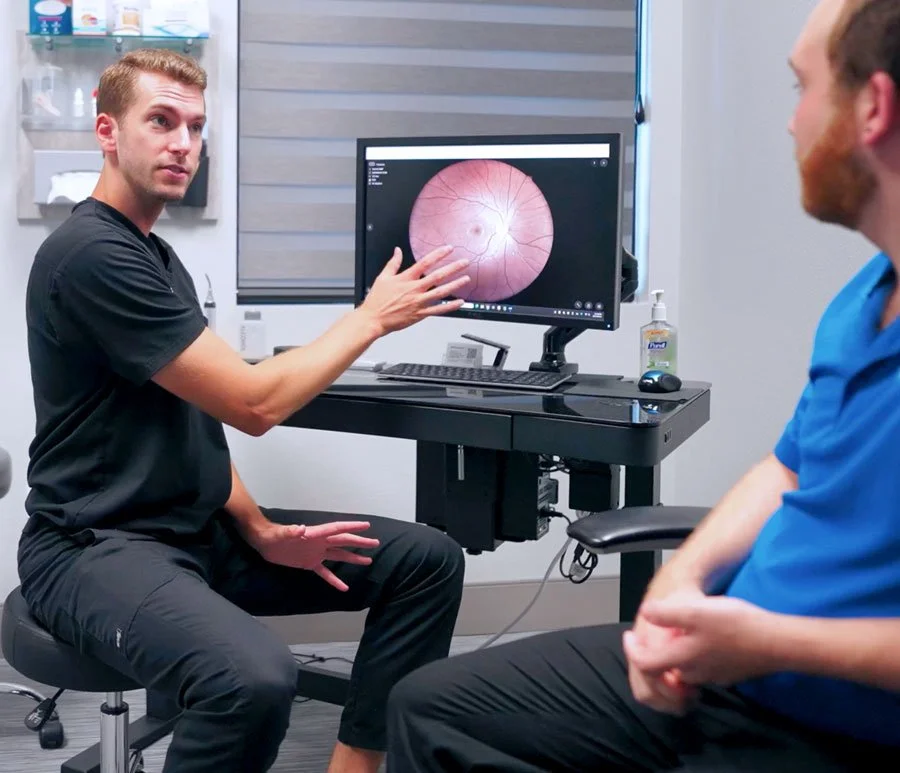
Eye Care Services
Emergency Eye Care
Urgent Care for Your Eyes
When it comes to emergency optometry, we take your condition very seriously. Our office is available for emergency appointments for all types of eye injuries and infections, including of removal of foreign bodies such as steel or wood. In addition we can treat and manage corneal abrasions, pink eye, injuries from trauma and allergies. If your eye is injured, do not try and judge the severity of it. Please contact us immediately and allow our doctors to evaluate the situation and lessen your risk of permanent damage. Skip ER wait times and let our trained eye doctors provide you with the help you urgently need.
Eye Emergencies Include
Chemical exposure
Concussion
Floaters in the vision
Dislodged contact lens
Eye infections
Eye trauma
Flashes of light
Foreign objects in eye
Lost or broken lenses
Red or painful eyes
Scratched eyes
Sudden loss of vision
Itchy or irritated eyes
Allergies
Pink eye
Corneal abrasions
Surgical Consultations
Enhance Your Vision with Surgery
When eye surgery is a viable option, we can guide you through what to expect with a surgical procedure. We work with patients and an Ophthalmologist to create a surgical plan to ensure optimal eye health. Whether you are interested in laser vision correction surgery, cataract removal or the like, our Eye Doctors are available to answer any question you may have.
Lasik Laser Vision Correction Surgery
Photo-Refractive Keratectomy (PRK)
Eye Muscle Surgery
Cataract Removal Surgery
Glaucoma Surgery
Diabetic Retinopathy Surgery
Macular Degeneration Surgery
Retina Surgery
Conditions We Treat
Working Together to Stay Healthy
It’s important to have your eye care provider and primary care doctor work as a team to monitor your overall health conditions like diabetes and high cholesterol. We recommend you see the same eye care provider each year. This allows the doctor get familiar with your visual history, which can help them notice changes in your eyes more easily.
-
We can detect early signs of Diabetic vision problems and offer tips to keep your vision free of problems. Most diabetes-related blindness can be prevented by an annual eye exam. Diabetic Retinopathy can occur up to seven years before diagnosis of Type 2 Diabetes, so an eye exam could lead to an earlier diagnosis for people who do not know they have Diabetes.
-
Dry eyes is a condition in which a person doesn't have enough quality tears to lubricate and nourish the eye and can become a chronic issue. Dry eyes can be uncomfortable and severely affect your vision. We offer personalized care and treatments such as; Punctal plugs, Restasis®, and other prescription eye drops to keep your eyes healthy and comfortable.
-
Macular degeneration (AMD) causes loss in the center of the field of vision. In dry AMD, the center of the retina deteriorates. With wet AMD, leaky blood vessels grow under the retina. We use advanced technology to detect early signs of macular degeneration. Once detected, we work with patients to provide treatment options.
-
Glaucoma is a group of eye conditions that can cause blindness. With all types of glaucoma, the nerve connecting the eye to the brain is damaged, usually due to high eye pressure. Often patients with glaucoma do not present symptoms. We provide diagnosis, treatment, and management of glaucoma. Our scanning laser helps us to diagnose glaucoma up to five years earlier than traditional methods.
-
Cataracts is known as the clouding of the normally clear lens of the eye. Most cataracts develop slowly over the course of many years. The primary symptom of cataracts is blurry vision. Having cataracts can be like looking through a cloudy window. The cloudy lens can often be replaced with a clear, artificial lens through a generally safe, outpatient procedure.
-
Latisse® is approved by the FDA to treat Hypotrichosis, the medical term for having insufficient or too few eyelashes. Latisse® is a prescription eye solution that helps eyelashes grow thicker and fuller. The prescription serum is applied to the base of the eyelashes on the upper eyelid using a special applicator. It is not applied to the lower eyelid or the eye itself. Get your free consultation today.
-
Migraines can cause intense, throbbing headaches, sensitivity to light, and visual disturbances, severely impacting your daily life. At Blink OD, we provide relief through specialized Avulux® Migraine Glasses, the first FDA-approved glasses specifically designed to manage migraine symptoms. These lenses filter harmful light frequencies that trigger migraines, helping to reduce frequency, duration, and intensity, allowing you to comfortably enjoy daily activities again.
-
Hearing loss affects millions of people and can significantly impact quality of life and social interactions. At Blink OD, we offer innovative Nuance Audio Glasses, a discreet and stylish solution for mild to moderate hearing loss. These advanced glasses feature built-in, over-the-counter hearing aids that enhance sound without requiring a prescription. With Nuance glasses, you can comfortably participate in conversations and reconnect with the world around you.
Treatable Conditions
Better Eyes for a Better Life
Our eyes are incredibly complicated and even the slightest disruption in the lens, cornea, retina, or iris can drastically change your vision. The good news is that many vision conditions can be corrected through a comprehensive eye exam followed by the correct prescription for glasses or contact lenses. Here are some of the most common, correctable vision problems.
Usually Treatable with Prescription Lenses
Presbyopia: This age-related condition causes a decrease in the eye’s ability to sharply focus on nearby objects due to the hardening of the eye’s lens.
Myopia: Commonly called “nearsightedness,” this vision condition results in seeing nearby objects clearly and faraway objects poorly.
Astigmatism: This visual impairment is the result of an irregular curvature in the eye. Instead of being shaped like a basketball, the eye is shaped more like a football. Astigmatism affects the way the eye processes light and results in varying degrees of blurred vision.
Hyperopia: Commonly called “farsightedness,” this vision condition results in seeing faraway objects clearly and nearby objects poorly.
May Need Treatment Beyond Prescription Lenses
Amblyopia: Commonly called “lazy eye,” this condition surfaces at an early age and involves favoring one eye over the other. When this occurs, the neglected eye rarely develops like it should, and it appears “lazy” next to the properly functioning eye.
Strabismus: Most commonly referred to as “crossed eyes,” this occurs when the muscles that surround the eye don’t work well together. As a result, each eye can simultaneously look in different directions, sending two different images to the brain.
Color Deficiency: The main characteristic of this condition, typically called “colorblindness,” is an inability to discern certain colors. Confusing red and green is the most common type of colorblindness.
Nyctalopia: Nyctalopia, or “night blindness,” is the inability to see well in poorly lit areas. Those with nyctalopia often have trouble driving at night. Night blindness is not actually a disorder, but a symptom of other eye disorders, such as cataracts or nearsightedness.
Photophobia: Those with photophobia, also called “light sensitivity,” often experience symptoms like headaches and eye strain when exposed to direct or bright light. Similar to night blindness, photophobia is not an eye disease; it’s a symptom of underlying conditions such as inflammation of the eyes.








